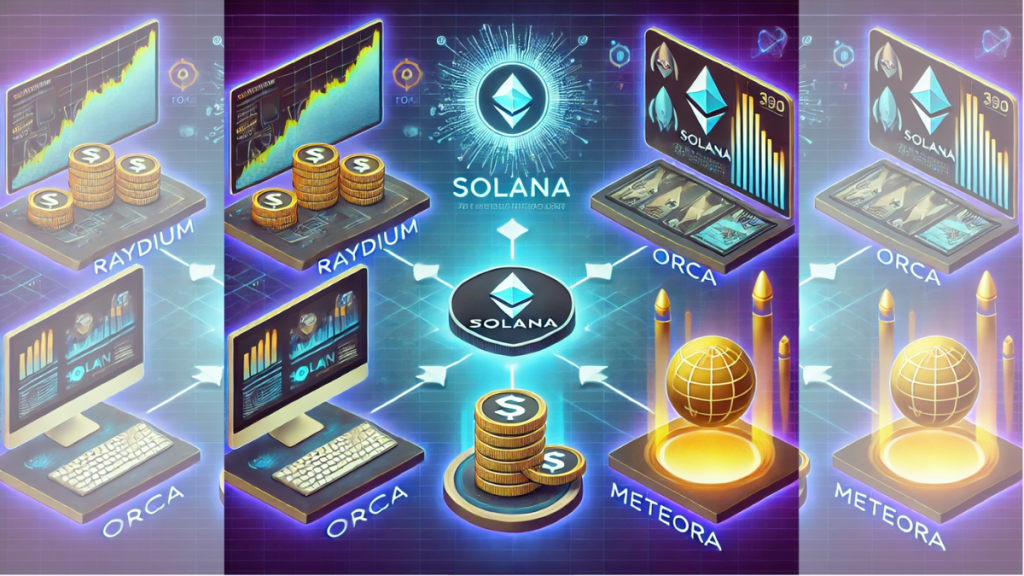In the dynamic world of decentralized finance (DeFi), listing your token on decentralized exchanges (DEXs) marks a crucial milestone in your project’s journey. But what exactly does “listing” mean, and why is it essential for your Solana token’s success?
Understanding Token Listing and DEX Types
Token listing refers to making your cryptocurrency available for trading on an exchange platform. On decentralized exchanges, this process involves creating liquidity pools – smart contract-based trading venues where users can swap tokens automatically. Unlike centralized exchanges, DEXs operate without intermediaries, using mathematical formulas to determine token prices and facilitate trades.
Types of Liquidity Pools You’ll Encounter
Before diving into specific exchanges, let’s understand the three main types of liquidity pools you’ll encounter:
Constant Product Market Maker (CPMM) Pools function using the famous x*y=k formula, maintaining a continuous liquidity curve. These are the most common and straightforward pools, perfect for new projects seeking stable trading conditions.
Concentrated Liquidity Market Maker (CLMM) Pools allow liquidity providers to focus their assets within specific price ranges, offering higher capital efficiency but requiring more active management.
Dynamic Liquidity Market Maker (DLMM) Pools, found on platforms like Meteora, adjust their parameters based on market conditions, potentially offering better protection against price volatility.
Major Solana DEXs and Their Unique Features
Raydium: The Power Player
Raydium stands out as Solana’s flagship DEX, offering both CPMM and CLMM pools. With its integration with Serum’s order book, Raydium provides superior liquidity and trading efficiency. Creating a CPMM pool costs 0.15 SOL, making it an accessible starting point for most projects.
Orca: The User-Friendly Option
Orca emphasizes simplicity and transparency. With no upfront pool creation fees (besides network fees) and a straightforward 0.3% trading fee structure, it’s highly approachable. The platform distributes 87% of trading fees to liquidity providers, with the remainder supporting ecosystem development and environmental initiatives.
Meteora: The Innovation Hub
Meteora introduces dynamic fee structures ranging from 0.15% to 15%, adapting to market conditions. While more complex, its DLMM pools offer sophisticated features for projects seeking advanced liquidity management options.
Why Start with Raydium?
For new projects, we recommend beginning your DEX journey with Raydium for several compelling reasons:
- Largest user base in the Solana ecosystem
- Deep liquidity across trading pairs
- Professional interface and robust documentation
- Strong integration with other Solana DeFi protocols
Detailed Pool Creation Process on Each DEX
Raydium: Your First Stop
- Initial Setup
- Navigate to Liquidity section in Raydium’s interface
- Connect your wallet with sufficient SOL for fees
- Click “Create New Pool”
- Pool Configuration
- Select token pairs (your token + base token like SOL/USDC)
- Choose pool type:
- CPMM (Constant Product) for standard trading
- CLMM (Concentrated Liquidity) for advanced price ranges
- Pay the 0.15 SOL protocol fee for CPMM pools
- Initial Liquidity Deposit
- Add equal USD value of both tokens
- Minimum recommended liquidity: $1000
- Ensure initial price matches market rates
- Complete wallet transactions
- Pool Management
- Monitor through Portfolio section
- Track fees (0.25% per trade, with 0.22% to LPs)
- Adjust positions through the standard positions interface
Expanding to Orca
Once established on Raydium, consider Orca for its user-friendly approach:
- Pool Initialization
- Access Liquidity section
- Select “Create a Pool”
- Connect wallet
- Token Selection
- Enter tokens by label, symbol, or mint address
- Review pool parameters
- Choose fee tier (standard 0.3% recommended)
- Initial Setup
- Set initial deposit parameters
- Consider fee tiers based on token volatility
- Complete preview and verification steps
- Launch Process
- Complete two required transactions:
- Pool creation (higher network fees)
- Initial liquidity deposit
- Allow 10 minutes for pool visibility
Meteora’s Dynamic Pools
For advanced liquidity management:
- Pool Type Selection Choose between:
- Volatile Pool: For non-stablecoin pairs
- Stable Pool: For stablecoin pairs (1:1 ratio)
- Memecoin Pool: For new memecoins with permanent liquidity
- Token Configuration
- Select tokens via dropdown, search, or mint address
- Verify Jupiter listing status
- Ensure token compatibility
- Initial Liquidity Strategy
- Begin with $600 minimum for Jupiter listing
- Wait for price equilibrium through arbitrage
- Add main liquidity once price stabilizes
- Maintain proper ratios based on pool type
- Pool Launch and Management
- Complete “Deposit and Create” process
- Monitor pool performance
- Add liquidity strategically
Best Practices Across All DEXs
- Initial Liquidity Management
- Start with sufficient liquidity ($1000+ recommended)
- Match market prices carefully
- Monitor early trading patterns
- Price Setting Strategy
- Research current market prices thoroughly
- Use price oracles when available
- Set competitive initial ratios
- Fee Optimization
- Understand each DEX’s fee structure
- Monitor fee accumulation
- Adjust strategies based on volume
- Ongoing Maintenance
- Regular liquidity monitoring
- Price range adjustments
- Active community engagement
Marketing Your Pool
- Community Announcement
- Share pool addresses across social channels
- Explain trading benefits and incentives
- Provide clear instructions for liquidity providers
- Incentive Programs
- Consider liquidity mining programs
- Implement trading rewards
- Create staking opportunities
- Cross-DEX Strategy
- Start with Raydium for maximum exposure
- Expand to Orca for additional user base
- Consider Meteora for advanced features
Conclusion
Creating and managing liquidity pools across Solana’s DEX ecosystem requires careful planning and execution. Start with Raydium for its robust infrastructure and user base, then expand strategically to Orca and Meteora as your project grows.
For new projects, remember to:
- Use Solr Network’s Solana Token Creator for secure token deployment
- Begin with adequate liquidity on Raydium
- Monitor and adjust positions regularly
- Expand to other DEXs strategically
Success in the Solana DeFi ecosystem comes from understanding each platform’s unique features and maintaining active pool management across all chosen DEXs. Start small, monitor closely, and scale based on performance and community feedback.

